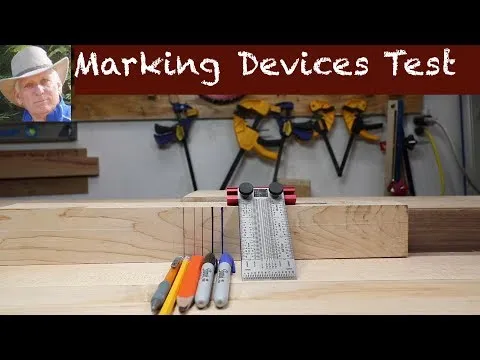
I used the Sharpie and made my mistake and then needed to get rid of that line. I started to wonder what should I mark with when I do a visible line? Does a Sharpie on a hardwood with grain, depending on the nature of the grain, is it soaking down in there and so then how much sanding do I have to do or thickness planing to get rid of it. I thought I'd do an experiment. That's what I'm gonna do today. So I grabbed a piece of White Maple and h a number of different marking instruments. First, I'm going to mark it with a mechanical pencil - probably be a good idea to get the lead out - I have Age Related Macular Degeneration in my left eye, so seeing these lines is sometimes problematic for me depending on the lighting and that's why I sometimes grab the Sharpie.
Next I'm going to use just a number two school pencil - basically stole it from my grandkids. Then I used a Contractor's Pencil from Home Depot. Next the black Sharpie and then a blue Sharpie. My question is, is that soaking down into the grain. What is it I'm after? I'm wondering whether or not using a Sharpie is a mistake. Am i creating more work for myself than I need to as far as getting the line sanded off of my workpiece before I put on my finish or whatever so Now to test this I'm going to run a sander for a while just on top of all of those with equal pressure and see in what order they are erased I am using 100 grit for the sandpaper Alright, can I tell anything? Kind of interesting - the millimeter lead mechanical pencil (and I'm not sure the hardness) line is still fairly visible. The #2 lead pencil is still a little bit there and the Home Depot contractor pencil is completely gone! I still have prominent lines for the black and the blue Sharpies.
So obviously they are sinking further down into the board. Let's do a little bit more sanding. Essentially all the lead pencils are gone - actually there's a little line for the millimeter mechanical pencil. I still have fairly visible line for the two Sharpies. My conclusion: I'm going to, when possible, mark with the contractors penci. Although when I need a nice sharp line I'll use my mechanical pencil with the for my Incra rulers. Going forward, I will no longer use permanent marker black or blue Sharpie's. Small Workshop Guy - signing off.
off you .
As found on Youtube
Click for more woodworking help